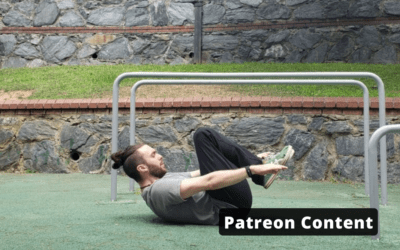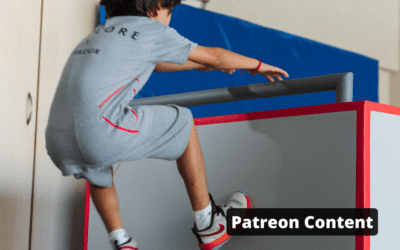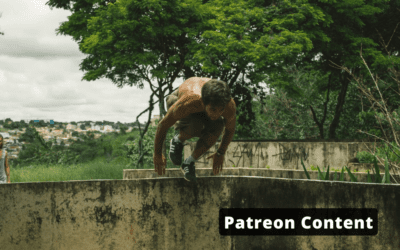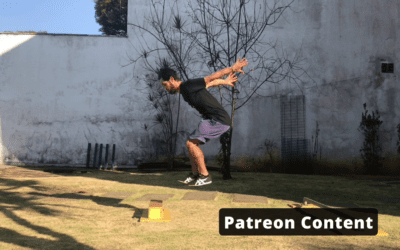
Where should I feel this Exercise?
Quads, Hamstrings, Glutes, and slight tension in your abs are the goals here.
What’s the Main Purpose?
The squat is great for understanding body alignment with your back and knees for the more high impact movements in Parkour. It can also help in building a base level of leg strength and/or mobility in a compressed position.
Tech Tips
This foundational strength movement has more to it than it seems. Be sure to focus on keeping a neutral braced position, centering your weight in the middle of your feet and keep your knees in line with your toes. Partial reps and various methods of assistance can help to progress with this move safely.

Mobility Defecit (MD)
Positive Ground Angle

A great environmental adaptation if your ankle dorsiflexion is lacking. The goal here is not to work on that issue, but to help you to keep a neutral posture while performing your squats. Use this progression to work on the strength while you also start building the mobility you need in your ankle.
Heels Off

Here you will have less foot contact area with the ground which equals less stability and more calf/soleus involvement. This variation helps a bit with your intersected balance and landings as well. You can definitely squat with your heels off to be able to go all the way down and perform specific transitions for different movements, it may also help build the ankle dorsiflexion mobility if you work on flexing your ankle while completing the movement but don’t expect as much carry over to your posterior chain compared to the normal squat.
ISO - Full Squat Hold
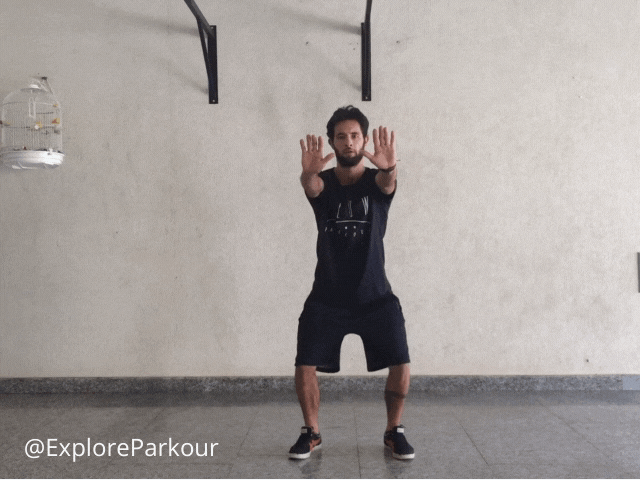
Spending some time in a full squat position can help you to open your hips and ankles. To get the strength benefits as well, make sure to keep your muscles activated by holding a neutral braced posture, not letting your hips tilt forward and your legs falling towards each other.
Remember these “improper” alignments are just in relation to transmitting and generating force (like with a landing.) Outside of that you should explore these positions for general body awareness, challenge and/or the brain-body connection.
Strength Defecit (SD)
Wall/Bar Assist
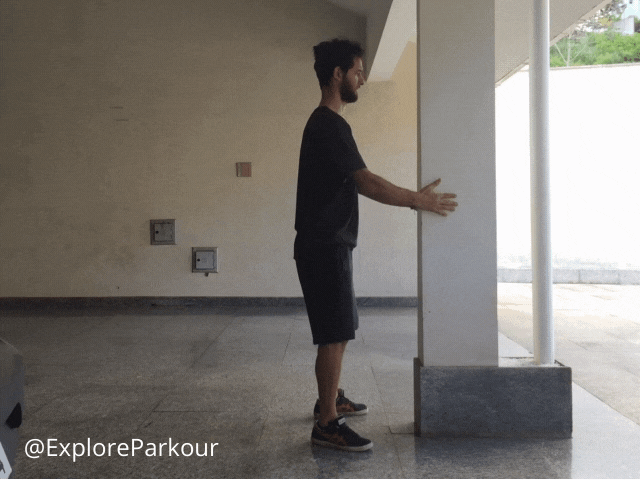
You can use this for a lack of strength for most squat variations and to help with a ankle/hip/low back mobility challenges as well. You can pull on the wall/bar to help you to keep your weight over your feet at the bottom of your squat.
-For Ankle Dorsiflexion Mobility: Be sure to lean into the ankles and drive the heels down to the ground.
ISO - Half Squat Hold

The Half Squat Hold can help you learn to absorb impact with more control for your landings . Training this can help build up strength to resist bottoming out in your jumps in an uncontrolled way. Try mixing this isometric position while balancing as well (heels off) for an interesting challenge which you can practice with different surfaces which will translate to the precision jump.

Environmental
Front Barrier
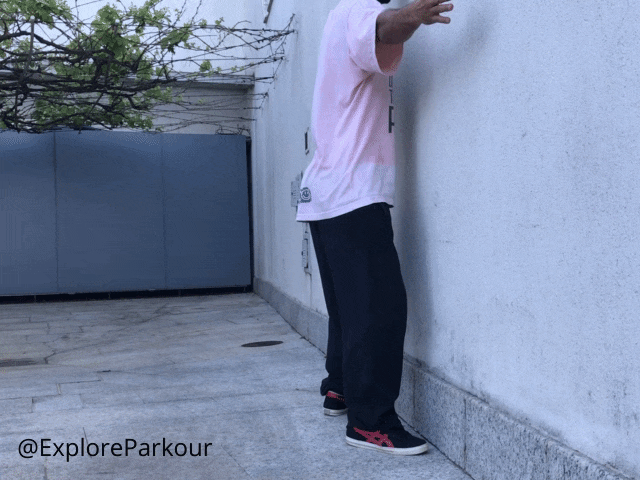
The wall here forces yout to be more upright in your squat, which puts more extension in your thoracis spine as well as more tibialis and adductor involvement if you are rotating externally as shown in the gif. We don’t usually activate these muscles as much during normal bodyweight squats so this can be a nice balancing exercise, or at the least an interesting challenge.
Negative Ground Angle
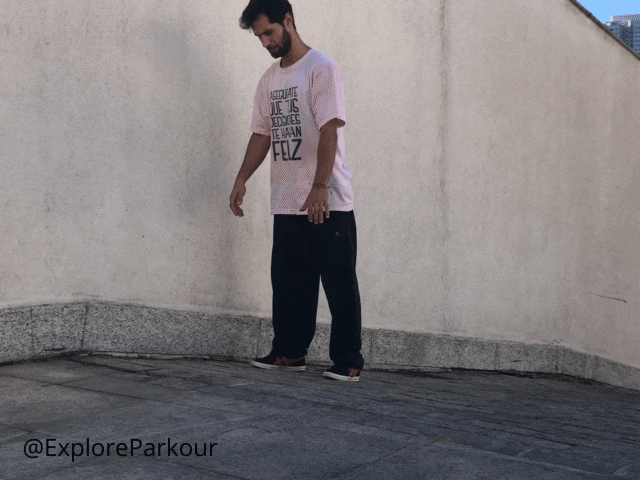
This is a great challenge to test and work on your dorsiflexion mobility. You will have to lean forward and use your tibialis more than usual to keep yourself balanced and reach the bottom or as close as possible. Try to progress by moving slowly so that you don’t lean so heavily on the counterweight, but be sure to take advantage of your torso flexion mobility, and the opportunity to work on it as well.
Restriction
Shrimp Squat

The Shrimp Squat is like a single leg half squat because of the single leg restriction and it’s agressive forward lean. This demands a lot from your standing quad, hip flexor, glute and ankle if you try to go lower. It’s also one good progression for the Pistol Squat.
Pistol Squat
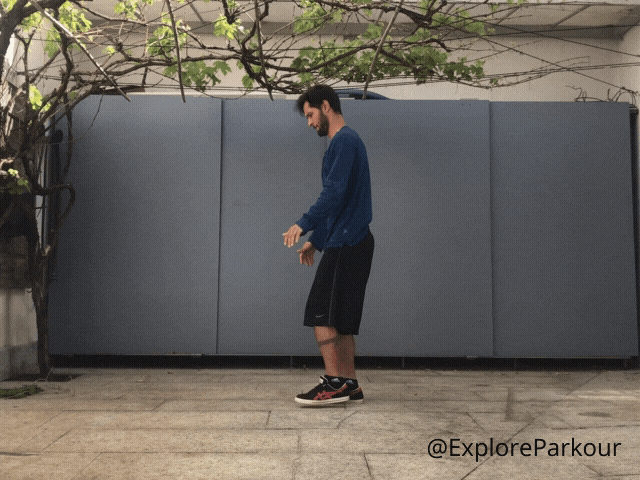
The Pistol Squat is one of the most common single leg squats. It requires a good balance of ankle, hip and spine mobility as well as glute, hamstring and quad strength. Performing it on a box or with a positive ground angle and/or with assistance(like the Wall/Bar Assist progression) can help you progress to the full movement on flat ground. Working on it properly can definitely improve your jumping/landing strength and stability.
Chair Pistol Squat

The Chair Squat adds a heavy hip and glute stretch to the pistol squat movement. It requres good ankle dorsiflexion for your support foot while your hip flexor and glute is being stretched. It’s an interesting variation to challenge/work on these capacities.
Dragon Pistol Squat
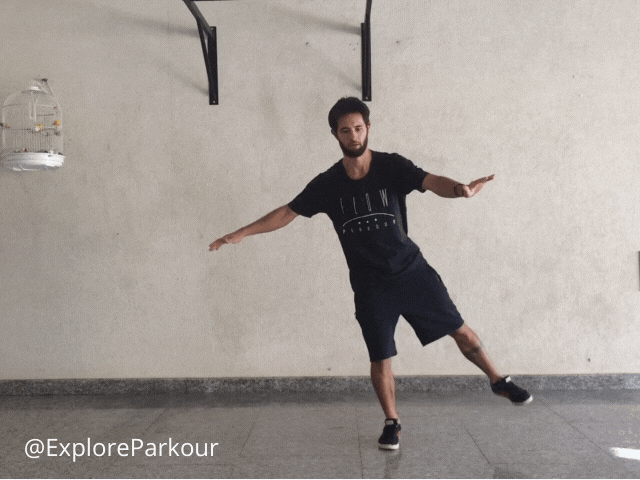
The Dragon Pistol Squat is famous because of it’s look and the different efforts that are combined together to perform it. Although your free leg will help with the counterweight, it takes a good quad, adductor and hip flexor mobility to keep this leg above the ground. The squatting leg will heavily recurit your glutes to keep you in the same position while you perform the squat. It can be a good challenge to aim for while as your single leg strength and hips mobility increases.
Tempo
Slow Motion Squat

This can be helpful to build resistance, stability and control while you’re squatting, landing or even with traversal challenges. It’s common to see people dropping down in their squats without actually controlling the movement (AKA bottoming out) and this movement helps teach your muscles how to keep that from happening. It isn’t useful to focus only on speed and explosive movements/exercises unless you have a solid base.
Rotation
Corkscrew Squat

The Corkscrew Squat is one of the most useful movement patterns to work on your ankle strength and mobility. It focuses on developing strength and ROM in ankle inversion but it has benefits overall similar to a squat just with this slightly different pushing angles. Additionally it’s an interesting coordination challenge/fun way to get up and down from the ground.
Body Position
Sissy Squat

The Sissy Squat can demand a lot from your knees and it’s important to be careful so you don’t overstress them. It’s a great challenge/exercise to get the most out of your quad muscles ROM while also focusing a lot of your toes/feet mobility as well. This movement is usually applied when you try to balance yourself after a precision landing.
Butterfly Squat
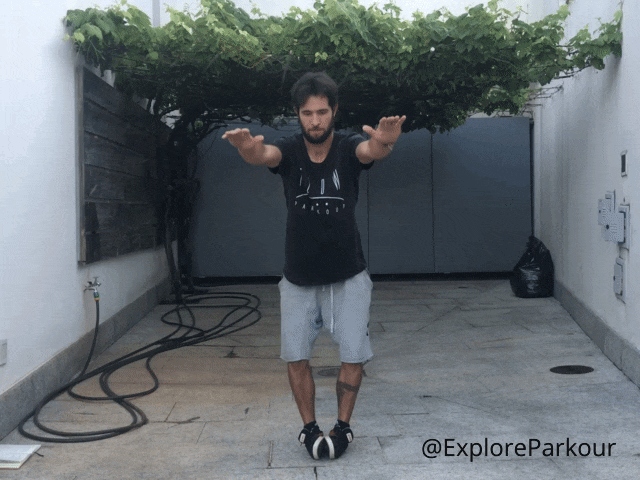
By exploring and training your body in positions that it might find during training, like the inversion of your foot, you will get your ankles ready and much more adaptable for moments like this. This squat variation should be done after warming up your ankles in this position, especially if you aren’t used to it.
As this is a fairly intense expression of ankle inversion comfort be sure to tread softly and progress into this before you attempt it. This and any of the other variations shown should not cause you pain.
Lunge Walk

The Lunge Walk and its variations are great for your hip flexor health in addition to working on your glute and quad strength. They can be a great resource for jumping, running and different step techniques. Make sure to keep a neutral braced posture with abs and glutes engaged while performing this move to get the most out of it. For the balance and application to jumps try to imagine a focal point in the middle of the ball of your foot where pour all your weight into while you lunge.
Cossack Squat Slide

The Cossack Squat Slide can help you work on your adductors as you try to keep your weight at the same place while sliding your free leg back to you. It’s important to strengthen and activate the muscles that don’t get used as much in general parkour movements so that your main muscles(like your quads for jumping) don’t get over used. Other than the safety benefits it also helps you increase your overall potential power output.
Peacock Squat

The Peacock Squat helps to work on the abductor muscles (in addition to the general quad,glute, hip flexor, low back work) as you try to balance to complete this movement, it’s useful as a progression for the Dragon Pistol squat variation. This exercise shares similarities with the normal set for the B-Twist and for the back cross footwork.
It’s important to strengthen and activate the muscles that don’t get used as much in general parkour movements so that your main muscles(like your quads for jumping) don’t get over used. Other than the safety benefits it also helps you increase your overall potential power output.
Combination
Step Up

The Step Up is a great single leg exercise that benefits a lot of the same things as a squat (plus potentially deeper glute involvement) while having the added benefit of putting all of your weight onto one leg. It can be adapted with many different modifiers depending on your specific goals. It’s a great exercise for techniques that use a step up as the take off (like running jumps or step up flips) and it can help you to work towards your explosive strength on one leg.
Intersected Balance Squat
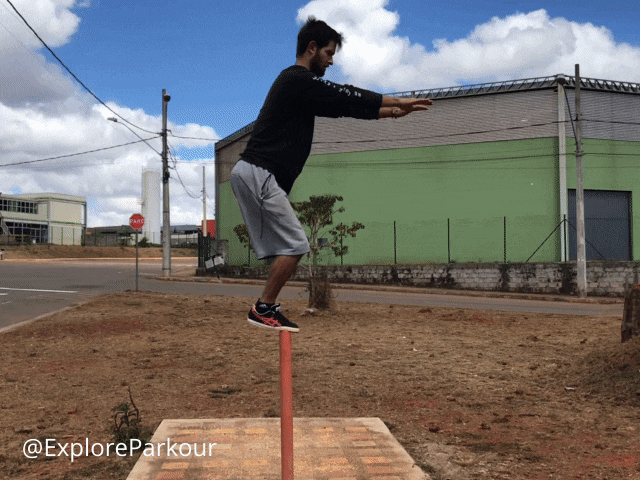
Whether you like it or not, this move is a basic parkour necessity so you can more readily explore movements with bars. The key is to try to hold the bar with your toes and raise your heels a little higher than usual, using your hips and arms as counterweight while your knees and ankles do the work. You can analyze and get more information about this technique at the Intersected Balance 2 Feet page.
Jumping Squats
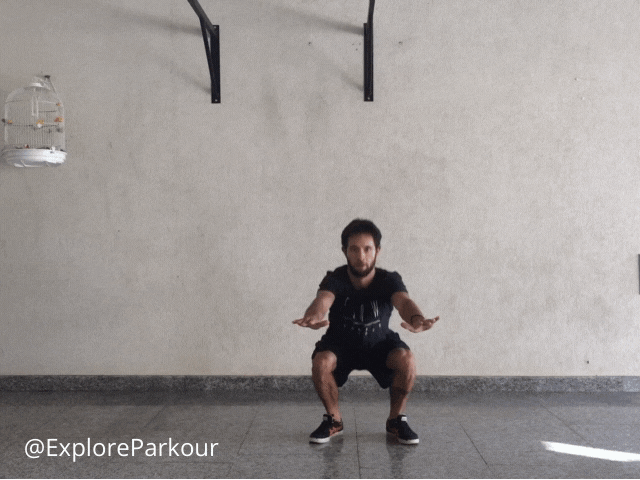
Jumping squats are great if you want to focus more on your explosive strength. This exercise can help you build your power and get your muscles/body use to jumping take-offs. It’s a good one to warm you up for a jumping session/challenges and you can also add some weights to push yourself during a conditioning training.
Box Jump
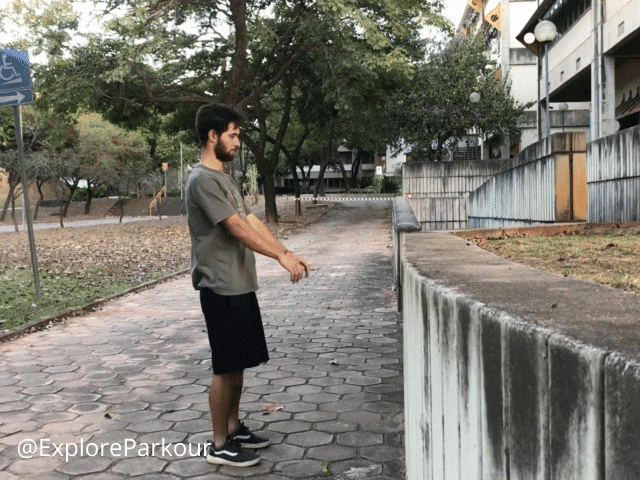
The Box Jump is a classic power exercise. It’s also a common jumping challenge if you’re having a Parkour session. It can help you to develop your take-off strength, range of motion and coordination for vertical jumps. If you’re pushing it to a 1 max. rep your hips mobility can help you to reach higher than usual by landing in a deep squat position. You can play with some variations like adding momentum with a run or a step to reach higher, landing with one foot at the top or doing it to a different surface/obstacle, like a bar. Make sure you’re not too close/far from your landing area and remember to swing your arms and tuck your knees up so you eventually don’t shin yourself.
Extra Weight
Back Squat
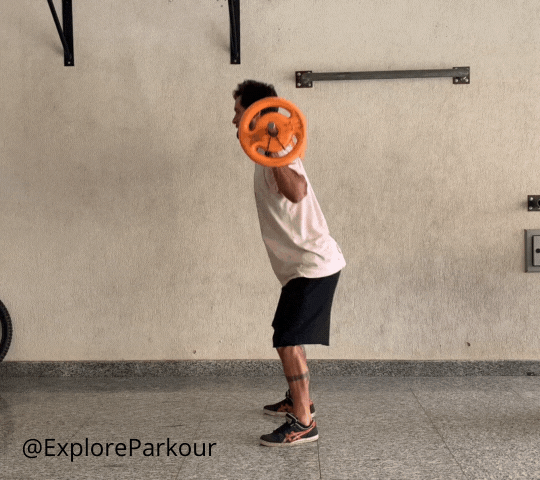
It is a great exercise to help you to build your strength and power when combined with speed exercises. This is a useful tool for parkour since it teaches your body how to use it’s max strength while also getting good CNS and muscular involvement. When we apply this to our jumps we can recruit our muscles with more efficiency as long as we train the squat with the jumping mindset. Make sure to take time and ensure proper technique before starting a weightlifting program for yourself. Be sure to seek a professional if you want to push this capacity further.
Front Squat
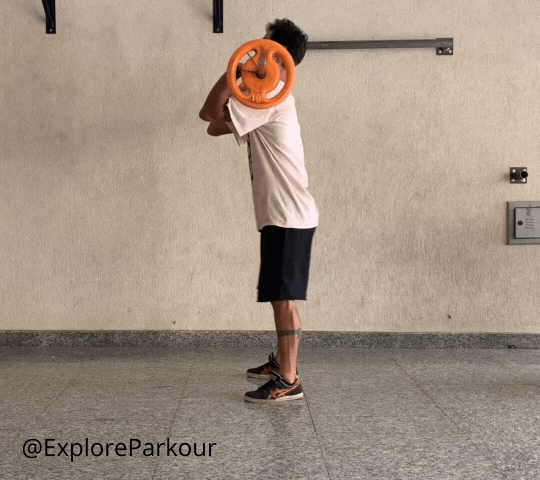
Front Squats are an excellent lifting variation because it moves the weight a bit more forward than a Back Squat. This slight change will target your upper/lower back and quads a lot more. This is useful for your jumps and controlling your weight more effectively.
Related Exercises
Tuck Up
Where should I feel this Exercise? Abs and hip flexors predominantly. Can also use the shoulders and pecs a bit for the arm movement. What’s the Main Purpose? Helps develop power for jumps, flips and other movements (like the cat pass) that require an explosive...
Related Techniques
Cat Leap
Also known as: Cat, Arm Jump, Cat JumpMovement Pieces The basic sequence of micro-transitions in this move is… - Like a Precision Jump, start with your toes at the edge of the obstacle. Squat - close to 1/3 - and bring your arms down and back as you lean forward -...
Cat Pass
Also known as: Kong, Monkey Vault or Saut de Chat.Movement PiecesThe basic sequence of micro-transitions in this move is… - Choose a stable obstacle close to your hip height, with short width and enough space to place your hands on the top. - Give yourself enough...
Plyometric Jump
Also known as: Plyo, Bounce, Double jump.Movement Pieces The basic sequence of micro-transitions in this move is… - Half way through your take off movement (which here is a precision jump but it can be many other techniques) bring your arms back and keep your torso...

